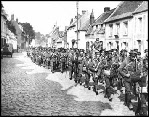

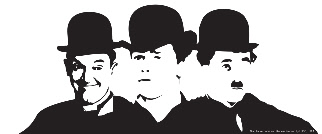

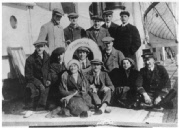
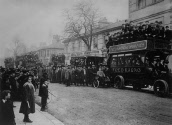
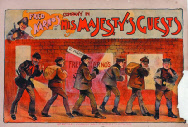


Fred Karno (26.3.1866-17.9.1941)
Fred Karno was born Frederick John Westcott, in Exeter but soon afterwards the family moved to Nottingham where he grew up. He began his stage career as an acrobat initially as an apprentice to ‘Olvene’, together they performed as ‘Olvene and Leonaro’. Karno then joined a touring circus where he was required to work with other acts, including the clowns. From them he learned the skills of physical comedy and slapstick which were to become his trademark. Leaving the circus he joined an acrobatic troupe called ‘The Four Aubreys’ with whom he toured Europe. Following this he found himself looking for work in London. On ‘Poverty Corner’ he fell in with two other acrobats Ted Tysall and Bob Sewall. Standing in for ‘The Three Carnoes’ one night, they were a great success and, changing the C to a K, they called themselves The Three Karnos. Fred Karno was born.
They had some success in the halls with their acrobatic act until one night a performer failed to appear and Karno suggested to the manager that they cover with a sketch. They performed an old circus routine ‘Love In a Tub’ which was a great success. At this time rough circus slapstick comedy was unknown in the music halls and the audience took to it immediately. Karno then went on to develop a repertoire of sketches; ‘Hilarity’, ‘Early Birds’, ‘Jail Birds’, etc. The licensing restrictions at the time meant that dialogue was prohibited and therefore these early sketches were almost entirely mime. As a result his team of comics became extremely highly skilled in purely visual and physical comedy with a basis in acrobatics.
From these early beginnings he went on to become one of the greatest impresarios of the music hall age, with troupes touring all over the world. He is credited with inventing the custard pie in the face gag, which is of course not true, none the less it does indicate how he was perceived as the Father of slapstick by his audiences. He is often accused of being a businessman but not a creative person. This is not the case, he performed in all the early sketches and later was instrumental in writing, directing and producing his shows but as his career blossomed he had an entire empire to manage and inevitably he quickly moved on from performing. Right up until his death in 1941 those performing his shows were sent polite little notes advising how to improve their performance or suggesting some additional gags – there is no doubt that Karno was a creative force.
He turned a row of houses in Camberwell into his ‘Fun Factory’ from where an army of writers, scenery builders, props makers, etc. operated. He branched out into theatre management and produced pantomimes and reviews as well as his sketches. He had over eighty sketches in his repertoire and worked on countless other pantomimes and productions.
His name became synonymous with anything ‘chaotic’ and during World War One the British Troupes frustrated with the disorganised nature of the war called themselves ‘Fred Karno’s Army’ and sang ‘We Are Fred Karno’s Army’ to the tune of the hymn ‘The Church’s One Foundation’ . The phrase became part of the language to describe any chaotic situation – there was in fact never a troupe called ‘Fred Karno’s Army’ or indeed ‘Fred Karno’s Circus’.
Karno revelled in his fame and was a master of self promotion, he was a pioneer of the publicity stunt and his name became so well known that a show with his name attached was sufficient to attract the audience regardless of who was starring. This enabled him to cast young unknown comics and in so doing he was responsible for giving many future stars their first big break. To them he was always ‘The Guv’nor’.
He was exceptionally good at spotting young talent and bringing them on, the most notable alumni of the Karno school being Charlie Chaplin, Syd Chaplin, Stan Laurel, Will Hay, Sandy Powell, Fred Emney, Albert Austin, Eric Campbell, Jimmy Nervo, Billy Ritchie and Billy Reeves. It was whilst on tour with Karno companies in America that some of these expert visual comics were poached by the embryonic silent film studios. As a result the early silent comedies of Chaplin, Laurel and Hardy et al are full of Karno trained British comics.
Chaplin and Laurel both held Karno in high regard, Stan Laurel said:
“Fred Karno didn’t teach Charlie and me all we know about comedy, he just taught us most of it. Above all he taught us to be supple and precise. Out of all that endless rehearsal and performance came Charlie Chaplin, the most supple and precise comedian of our time.”
There were others doing sketch material of course but Karno’s was arguably the most influential and certainly his legacy is the greatest. He pushed the boundaries of comedy in the music hall and as time moved on his sketches introduced dialogue and became verbal as well as physical comedies. These were the first ‘comedy sketches’ as we would think of them today. These later sketches included ‘The Football Match’, ‘The Wontdetania’, ‘The Hydro’, and many more.
His most successful sketch was ‘Mumming Birds’ in America re-titled ‘A Night In An English Music Hall’. This sketch ran for forty years with revivals by Karno’s sons as late as the mid 1940s. The show was a show within show with a series of terrible music hall acts being heckled by a drunken Toff and a naughty schoolboy, sitting in theatre boxes. It was his performance as the drunken Toff which made Chaplin’s name and bought him to the attention of Mack Sennett at Keystone studios in America in 1912. Stan Laurel also appeared in Mumming Birds alongside Chaplin, they shared digs on the Karno tours of America in 1910 and 1912, and Laurel is often described as being Chaplin’s understudy. Although Laurel said this about himself, in truth Chaplin had no understudy, all the actors in a Karno troupe had to be able to cover for each other Chaplin included, he was no different to his fellow players. Laurel always recognised Chaplin’s brilliance and was quick to credit him – his description of himself as Chaplin’s understudy being a typical Laurel self effacing comment, Chaplin in contrast never acknowledged Laurel’s role in his early career.
In 1911 at the height of his fame Karno built a palatial houseboat on the Thames at Hampton called Astoria, which cost around £7000 (approximately £400,000 in today’s money), this he followed with a massive investment in a new hotel on Tagg’s Island he called ‘Karsino’. It was the playground of Edwardian High Society but with the onset of World War One and the gradual decline of the Music Hall which followed, the hotel ultimately broke him. He was declared bankrupt in 1927.
He headed to Hollywood in 1929 where he caught up with Chaplin and Laurel. Hal Roach gave Karno a job as an assistant director and he spent six months working with Laurel and Hardy. However having spent forty years as ‘The Guv’nor’ Karno could not work within a studio system under directors and producers he felt lacked his abilities and experience. He returned to England in 1930 having made no impression on Hollywood. He then set about reinventing himself and created a new comedy troupe he called ‘Karno’s Krazy Komics’. A UK tour with their first production ‘Laffs’ was a huge success and was the inspiration for George Black’s Crazy Shows at the London Palladium. Karno was influential in casting Nervo and Knox, Flanagan and Allen and Naughton and Gold as the core of the show and ‘The Crazy Gang’ was born. Although this wasn’t a Karno show, his influence was all over it. They went on to become the most successful comics of the 30s and 40s and every theatre in the country ran ‘Crazy Weeks’.
In 1935 he embarked on a new career as a film producer and invested in a British feature film starring Rob Wilton, called Don’t Rush Me, a film version of his sketch ‘Hot and Cold’. It was a total flop and he was once again bankrupt. He retired to Dorset and died penniless and forgotten in 1941.
As a man he had a reputation as a hard task master and a womaniser. He was married twice and had two sons. Much of the information readily available on Karno comes from a biography written in the early 1970s by a tabloid journalist who’s sources were largely Karno’s ex-wife’s friends. It paints a very dark picture of the man but has been demonstrated to be full of inaccuracies. This biography has however left his reputation undeservedly tainted. Whatever the realities of his personal life, Karno was a huge influence on early comedy, slapstick and the most important comedians of the early twentieth century and as such he deserves to be remembered as ‘The Father of Slapstick’. David Crump is currently working on a new biography of Karno.

